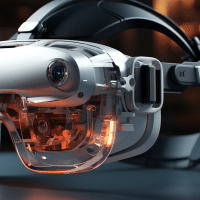
The world of virtual reality (VR) is rapidly evolving, and by 2030, it is expected to have a major impact on the digital landscape. As technology advances, VR will become more accessible and immersive, allowing users to experience a world beyond their own. Imagine stepping into a virtual realm where you can explore ancient civilizations, swim with dolphins in the depths of the ocean, or even interact with your favorite fictional characters.
With the potential to revolutionize the way we interact with the digital world, VR in 2030 will be a powerful tool for entertainment, education, and communication. From virtual classrooms that transport students to historical events to virtual concerts that let you experience the energy of a live performance from the comfort of your own home, the possibilities are truly endless. With the help of VR, the digital world of the future will be more interactive, immersive, and engaging than ever before, opening up new horizons of creativity and exploration.
Exploring the Potential of VR in 2030
As we eagerly anticipate the future of virtual reality (VR) in 2030, it becomes increasingly evident that the realm of possibilities knows no bounds. The rapid advancements in technology are propelling VR into a realm of accessibility and immersion like never before, enabling users to delve into and encounter digital worlds in unprecedented ways. By the time 2030 arrives, VR will undoubtedly have entrenched itself as an indispensable aspect of our lives, boasting an array of applications spanning entertainment, gaming, education, and healthcare.
The potential of VR in 2030 is truly exhilarating. With the assistance of advanced AI and machine learning, users will seamlessly interact with virtual environments, immersing themselves in experiences that mirror real life with unparalleled naturalness and intuition. This will unlock a treasure trove of possibilities, enabling virtual travel experiences that transport individuals to far-flung destinations, virtual shopping that transcends the boundaries of physical stores, and even virtual job interviews that revolutionize the employment landscape.
Moreover, VR will revolutionize education by offering immersive learning experiences, empowering students to explore and acquire knowledge within a virtual realm. In the healthcare sector, VR will play a pivotal role in diagnosing and treating patients, while also providing virtual therapy sessions that bridge the gap between physical and mental well-being.
The horizons of VR in 2030 are truly boundless. With the aid of cutting-edge technology, we can enthusiastically envision a future where virtual reality seamlessly intertwines with our lives, enabling us to explore and encounter the world in ways that were previously unimaginable. The immersive power of VR will transcend the confines of our physical reality, inviting us to embark on limitless adventures and experiences that will redefine our perception of what is possible.

The Impact of VR on the Digital Landscape
The digital landscape of the future is undoubtedly destined to be shaped by the profound impact of virtual reality (VR). By the year 2030, VR technology is expected to become ubiquitous, permeating various aspects of our lives and revolutionizing the way we interact with the world around us.
Imagine a future where immersive gaming experiences transcend boundaries, enabling us to step into virtual worlds that defy reality. Virtual meetings and conferences will seamlessly connect people from different corners of the globe, fostering collaboration and idea exchange on an unprecedented scale.
But that’s not all. In the year 2030, VR will also redefine the way we consume media. With its ability to create lifelike, interactive environments, VR will transport us to new dimensions of storytelling and exploration. We’ll be able to wander through virtual museums, embark on virtual tours of far-flung destinations, and even attend virtual concerts and events, all from the comfort of our own homes.
The possibilities that VR holds for the year 2030 are truly exhilarating. With its potential to completely transform the way we interact with the world, VR is poised to leave an indelible mark on the digital landscape of the future.
The Future of VR Hardware
The future of VR hardware is an incredibly exciting prospect. By 2030, we can anticipate a significant transformation in the way we engage with the digital world. Advanced VR technology will open up new frontiers, allowing us to explore virtual worlds with unparalleled realism and immersion. The hardware landscape will undergo a remarkable evolution, introducing innovative headsets, controllers, and peripherals that offer seamless access and interaction with virtual reality.
In the immersive VR landscape of 2030, the possibilities are truly boundless. A myriad of applications will emerge, revolutionizing not only the gaming industry but also education, healthcare, and various other sectors. Imagine attending virtual classrooms that simulate real-life scenarios, allowing students to gain practical experience without leaving their homes.
Envision exploring historical landmarks or distant planets with unparalleled depth and authenticity. The integration of haptic feedback devices, motion tracking systems, and other cutting-edge hardware will further enhance the sense of presence and interactivity, blurring the lines between the physical and virtual realms.
With the right hardware and technology, we can eagerly anticipate a future where virtual reality becomes an integral part of our lives, transforming how we learn, work, socialize, and entertain ourselves. The immersive experiences and limitless possibilities that await us in the VR landscape of 2030 are truly awe-inspiring, paving the way for a digital revolution like never before.
The Future of VR Apps
The future of VR apps is an incredibly exciting and promising prospect. By the year 2030, we can anticipate a world where virtual reality has seamlessly integrated into our everyday lives, transforming the way we perceive and interact with technology. From captivating and immersive gaming experiences that transport us to fantastical realms, to virtual meetings and conferences that connect us across vast distances, VR will truly revolutionize our existence in ways we can only begin to fathom.
In 2030, virtual reality will transcend its role as a mere gaming platform and emerge as a powerful tool for communication, collaboration, and creativity. With advancements in technology, VR will possess the capability to generate breathtakingly realistic and interactive environments that enable us to explore uncharted territories and encounter new experiences.
The impact of VR will extend beyond entertainment, finding applications in diverse fields such as education, healthcare, and even the workplace, enabling us to learn, heal, and collaborate like never before.
Envision a future where we can use VR to transport ourselves to historical events, enabling us to witness pivotal moments in time firsthand. Picture a world where medical professionals can utilize VR to simulate complex surgeries, refining their skills in a safe and controlled environment. Imagine a workspace where teams collaborate seamlessly, regardless of physical location, thanks to the immersive capabilities of VR.
The possibilities for VR in 2030 are boundless. With the continuous advancements in cutting-edge technology, we have the potential to create virtual worlds that are even more immersive, realistic, and engaging than ever before. Through VR, we will have the opportunity to explore new horizons, acquire new knowledge and skills, and forge connections with others in real-time, transcending the limitations of physical boundaries.
Undoubtedly, the future of VR apps is poised to be an exhilarating one. As we embrace this transformative technology, it will undoubtedly shape the digital landscape of the future, opening up a world of endless possibilities and revolutionizing the way we experience and interact with our digital surroundings. The journey ahead is thrilling, and the impact of VR is set to leave an indelible mark on our collective human experience.
The Cost of VR in 2030
The future of virtual reality (VR) in 2030 is an incredibly exciting prospect that holds immense potential. With the rapid advances in technology, we can expect a multitude of possibilities and innovations in the world of VR.
In 2030, VR will revolutionize the gaming industry, offering gamers immersive experiences that transport them to captivating virtual worlds. Not only will gamers be able to see and hear their surroundings, but they will also be able to feel and interact with the virtual environment like never before. From adrenaline-pumping action games to thought-provoking puzzle-solving adventures, VR in 2030 will offer an unparalleled level of realism and engagement.

Moreover, the potential applications of VR in fields like education, training, and healthcare are boundless. Imagine students being able to explore historical events or complex scientific concepts through immersive VR simulations. Professionals in various industries can enhance their skills and knowledge through virtual training programs, allowing for safer and more efficient learning experiences. Additionally, VR can revolutionize healthcare by providing realistic simulations for medical training, therapy, and pain management, ultimately improving patient outcomes.
As the cost of VR technology continues to decrease, it will become more accessible to the average consumer in 2030. This increased affordability will enable a broader demographic to enjoy the benefits of VR, fostering its widespread adoption. The combination of reduced costs and advancements in both hardware and software will drive innovation, as developers and creators push the boundaries of what is possible in the world of VR.
In conclusion, the future of VR in 2030 is filled with boundless possibilities and potential. From immersive gaming experiences to transformative applications in education, training, and healthcare, VR will redefine how we interact with digital content and revolutionize various industries. As technology continues to evolve, the cost of VR in 2030 will play a significant role in determining its success and widespread integration into our daily lives.
The Benefits of VR in 2030
As we look ahead to the future, it is evident that virtual reality (VR) will play an increasingly significant role in our lives. By the year 2030, advancements in VR technology will revolutionize various aspects of society, spanning from entertainment to education and beyond. The potential of VR in 2030 is truly limitless, offering a powerful and immersive medium for exploring uncharted territories, acquiring new skills, and even forging innovative business ventures.
Imagine a world where VR enables us to embark on virtual journeys to far-flung places, allowing us to witness breathtaking landscapes and experience diverse cultures without ever leaving the comfort of our homes. With VR, we will have the ability to dive into the depths of the ocean and encounter marine life up close, unlocking a whole new dimension of exploration and discovery.
VR in Medicine: Bridging Gaps and Improving Access to Care
VR Tech Unleashed: Revolutionizing Industries and Beyond
In the realm of education, VR will serve as a transformative tool, creating virtual classrooms that offer interactive and engaging learning experiences. Students will have the opportunity to step inside historical events, conduct scientific experiments in simulated environments, and engage in collaborative projects with peers from around the globe.
Moreover, businesses will harness the power of VR in 2030 to create virtual stores and showrooms, revolutionizing the way products are showcased and experienced. Customers will be able to virtually browse and interact with products, gaining a realistic sense of their features and functionalities. This immersive shopping experience will enable consumers to make more informed purchasing decisions and empower businesses to provide a truly personalized and engaging customer journey.
The potential of VR in 2030 is not confined to entertainment, education, and commerce alone. It will extend its influence to various fields, including healthcare, architecture, and training simulations, to name just a few. From aiding in medical procedures and creating virtual architectural walkthroughs to enhancing training programs for professionals in high-risk industries, VR will reshape the way we work, learn, and interact with the world around us.
In conclusion, the future of VR is brimming with excitement and endless possibilities. Its ability to create immersive experiences and transport us to new realms will redefine the digital landscape, fueling exploration, innovation, and personal growth. With VR at our fingertips, we will unlock new dimensions of knowledge, creativity, and connectivity, shaping a future where the boundaries of reality and imagination blur seamlessly.
In conclusion, Virtual Reality (VR) in 2030 is poised to completely revolutionize the digital landscape. With its immense potential to transform not only how we interact with technology but also how we work and play, VR is set to become an integral part of our daily lives. The future of VR hardware and applications promises to be even more powerful, affordable, and accessible than ever before.
Imagine a world where VR not only offers immersive experiences but also has the ability to significantly reduce costs and increase efficiency in various industries. From healthcare and education to entertainment and communication, VR has the potential to reshape the way we approach these sectors, unlocking new possibilities and opportunities.
As we step into the future, it’s crucial to prepare ourselves for the boundless potential of VR in 2030 and beyond. Let’s embrace the advancements in VR technology, explore its limitless applications, and get ready to embark on an extraordinary journey that will shape the digital landscape of tomorrow. The future is bright, and VR is at the forefront of this transformative revolution. So, let’s dive into the incredible possibilities of VR and embrace the future that lies ahead!


















